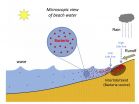Report: one in four Baltimore residents live in a food desert
Food maps depict city neighborhoods including areas with limited access to healthy foods
2015-06-10
(Press-News.org) A new report by researchers at the Johns Hopkins Center for a Livable Future (CLF), in collaboration with the Baltimore Food Policy Initiative, found that one in four of the city's residents live in so-called food deserts with limited access to healthy foods.
The report, released today, is available online on the Center for a Livable Future's Maryland Food System Map website. The findings were highlighted at a press conference featuring Baltimore City Mayor Stephanie Rawlings-Blake, other city officials and CLF representatives.
Neighborhoods with food deserts have higher rates of diseases linked to unhealthy diets, including cardiovascular disease and diabetes. Overall mortality rates are also higher in these areas. While not the only factor impacting these outcomes, food deserts can be a significant contributor, the researchers say.
The report found that 34 percent of African Americans live in food deserts, compared to only eight percent of white residents. Children are also disproportionately affected, with 30 percent of Baltimore City's school-aged children living in food deserts.
'These statistics highlight the inequities in healthy food access in Baltimore City,' says Robert Lawrence, M.D., director of the CLF, which is based at the Johns Hopkins Bloomberg School of Public Health. 'The maps included in the report show where the need for healthy food is concentrated, highlighting where residents may be at a higher risk for diet-related health problems. Now that we know more clearly where there are needs, we can work with the city to ensure all residents have access to healthy food.'
The report defines a food desert in Baltimore City as an area where residents must travel more than one-quarter of a mile to reach a supermarket, the median household income is at or below 185 percent of the federal poverty level, over 30 percent of households lack access to a vehicle, and the supply of healthy food is low.
The methods used are unique to Baltimore City and are an accurate reflection of what residents experience in their communities. The analysis is the first to include access to a vehicle and the supply of healthy food in all City food stores in the criteria, in addition to the distance to supermarkets and household income, which are commonly included in food desert assessments.
'As a community advocate, I'm very happy to see the challenges in the food environment taken seriously and addressed with a multi-tiered approach,' says Joyce Smith, a Baltimore City resident and community liaison for the CLF. 'Bringing the community to the table alongside partners at the city and Johns Hopkins is crucial for solving this issue.'
The map and report will be used by researchers at the CLF and Baltimore City officials as a roadmap to guide ongoing policy and programs to improve economic development, city planning and health department strategies along with continued CLF research on healthy food access in Baltimore City.
INFORMATION:
The Center for a Livable Future's research for this report was supported in part with a gift from the GRACE Communications Foundation.
ELSE PRESS RELEASES FROM THIS DATE:
2015-06-10
MIAMI - An international team, led by researchers at the University of Miami (UM) Rosenstiel School of Marine and Atmospheric Science, has developed a new, timelier method to identify harmful bacteria levels on recreational beaches. The new model provides beach managers with a better prediction tool to identify when closures are required to protect beachgoers from harmful contaminates in the water.
"The development of this new model has allowed us, for the first time, to estimate contamination levels on beaches subject to nonpoint source pollution, in particular from ...
2015-06-10
Short boys are three times more likely than short girls to receive recombinant human growth hormone treatment for idiopathic short stature (ISS), even though in a general pediatric population, equal proportions of both genders fall under the height threshold designating ISS. Researchers who analyzed records of over 283,000 U.S. children and adolescents found a clear-cut and persistent gender bias in the provision of treatment.
"Growth is an important sign of child health, so growth failure merits equal consideration for both boys and girls," said study leader Adda Grimberg, ...
2015-06-10
DARIEN, IL - A new study suggest sleep problems and energy product use are associated with increased alcohol use in teens, even after controlling for sociodemographics and mental health.
Results show that both sleeping problems and use of energy products are associated with greater risk of alcohol use in teenagers, according to a study conducted by the RAND Corporation.
"Our findings suggest that teenagers may be using highly caffeinated energy products to cope with sleep loss, and both sleep problems and energy product use are associated with increased risk of alcohol ...
2015-06-10
INDIANAPOLIS -- The worldwide demand for legumes, one of the world's most important agricultural food crops, is growing; at the same time, their production has been adversely affected by drought. In an Indiana University-Purdue University Indianapolis research paper published today in the journal PLOS ONE, researchers provide information that could help agricultural planning and management to minimize drought-induced yield losses.
Legumes, which include peas, beans, peanuts and alfalfa, are grown in almost every climatic region and are second only to cereals in terms ...
2015-06-10
Plants can undergo the same extreme 'chromosome shattering' seen in some human cancers and developmental syndromes, UC Davis researchers have found. Chromosome shattering, or 'chromothripsis,' has until now only been seen in animal cells. A paper on the work is published in the online journal eLife.
The process could be applied in plant breeding as a way to create haploid plants with genetic material from only one parent, said Ek Han Tan, a postdoctoral researcher in the UC Davis Department of Plant Biology and first author on the paper. Although plants don't get cancer, ...
2015-06-10
The public can now make a more informed choice about long-term care thanks to a new online tool launched today that compares facilities across Canada based on nine indicators such as safety, quality of life and general health of residents.
Researchers at the University of Waterloo led the development of the assessment criteria and quality measures that will allow people to compare data of more than 1,000 facilities. They are members of interRAI, a global network developing assessment and screening tools to support vulnerable populations.
'This website provides Canadians ...
2015-06-10
A large data-mining study carried out by investigators at the Stanford University School of Medicine has linked a popular class of heartburn drugs to an elevated risk of heart attack.
Proton-pump inhibitors, or PPIs, are among the world's most widely prescribed drugs, with $14 billion in annual sales. They are effective at lowering the acidity of the stomach, in turn preventing heartburn, a burning sensation in the chest that occurs when stomach acid rises up into the esophagus. In any given year, more than 20 million Americans -- about one in every 14 -- use PPIs such ...
2015-06-10
Chimpanzee may be able to use facial expressions and vocalizations flexibly, notably during physical contact play, according to a study published June 10, 2015 in the open-access journal PLOS ONE by Marina Davila-Ross from University of Portsmouth, UK and colleagues.
The ability to flexibly produce facial expressions and vocalizations has a strong impact on the way humans communicate, but scientists' understanding of nonhuman primate facial expressions and vocalizations is limited. The authors of this study investigated whether chimpanzees produce the same types of ...
2015-06-10
People reflecting on a roundtrip walk estimated that the return trip took less time than the outward trip, according to a study published June 10, 2015 in the open-access journal PLOS ONE by Ryosuke Ozawa from Kyoto University, and colleagues.
Many have experienced the "return trip effect," where the return trip seems shorter than the outward trip, even when the trips actually took the same amount of time. Scientists have studied the effect, but haven't confirm its existence in the context of the environment and duration of the real-life trip. To better understand the ...
2015-06-10
This news release is available in French.
A study at the University of Montreal shows that the market share of the five largest research publishing houses reached 50% in 2006, rising, thanks to mergers and acquisitions, from 30% in 1996 and only 20% in 1973. "Overall, the major publishers control more than half of the market of scientific papers both in the natural and medical sciences and in the social sciences and humanities," said Professor Vincent Larivière of the School of Library and Information Science, who led the study. "Furthermore, these large commercial ...
LAST 30 PRESS RELEASES:
[Press-News.org] Report: one in four Baltimore residents live in a food desert
Food maps depict city neighborhoods including areas with limited access to healthy foods

